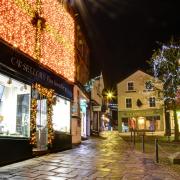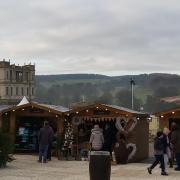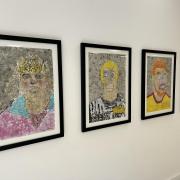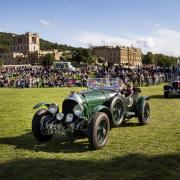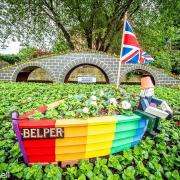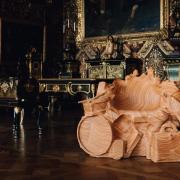Recalling the life of George Bissill (1896-1973) - miner, First World War veteran, artist and designer

One hundred years ago in 1915 a Derbyshire collier gladly joined the army to escape the mines. But in the Great War the 18-year-old former Heanor schoolboy George Bissill unwittingly encountered another life underground which proved more hellish than anything he endured at the coal face. Like many mine workers he was made a ‘Sapper’ – a Private in the Royal Engineers – and set to work in France tunnelling under No Man’s Land towards enemy lines.
Although spared the horrors of the battlefields above, the Sappers’ subterranean labours held additional terrors. Potentially digging just yards from their German counterparts – who were tunnelling the opposite way – the sense of the unknown for the ‘sewer rats’ was chilling. Tunnel collapse, gassing, flood, explosions and unexpected enemy encounters were ever-present dangers – in an environment that even hardened miners found horribly uncomfortable.
Bissill survived the ordeal but suffered lasting emotional trauma. Yet from those darkest days emerged something remarkable. Ten years later at a smart London gallery 28-year-old artist George Bissill held his first solo exhibition. The art world cognoscenti heaped gushing acclaim on the ‘Pitman Painter’ for the ‘raw emotion of his touchingly fresh talent’ and ‘his inner consciousness of what is truly real’. The show caused quite a sensation, and collectors snapped up Bissill’s work. How his world had changed – he soon travelled to Paris where he received similar praise. His career as an artist blossomed.
But only for a time – Bissill died in 1973 largely forgotten. The ever-fickle art world had dimmed his spotlight to almost nothing. Yet there are now signs of a revival. His remarkable story is being used in educational material, and salerooms are achieving improving prices for his work. Time to illuminate his name once more...

George William Bissill was the son of Langley Mill miner George Bissill and his Gloucestershire-born wife Mary Ann May. Pending the arrival, his mother left the Derbyshire-Nottinghamshire borders for the support of her family home in Fairford in the Cotswolds, where George William was born on 22nd June 1896.
But the boy was ‘Derbyshire’ by all but birthplace – mother and son soon rejoined father in a modest terraced ‘cottage’ at 45 Ebenezer Street, Langley Mill. Since his father was a miner, it was taken for granted that George would follow. He started aged 13 as a pony driver, and two years later began heavier work underground.
But he already had interests and experience which would help shape his life’s course – a curiosity for art, and a decent education. George recalled: ‘I loved to draw and paint. When I was aged about three I would draw on the walls and doors of the cottage, to the amazement and anger of my father. So he bought me some coloured crayons and paper.’
In the opening decade of the 20th century George developed his artistic interest at Heanor Technical School – later rebuilt and in 1948 restyled Heanor Grammar School. That respected institution ceased operation in 1976, and the future of the Grade II Listed building is currently under debate. But George Bissill’s alumnus status is eternally etched – he left aged 13 with the sound grounding which helped him develop into a notable Old Heanorian.
His art career lay in the future, but Bissill already worked with an artist’s eye: ‘In the mines I learned the significance of the great effort that is daily expended in the dark, the crouching attitudes, the strain of muscles, and the constant anxiety.’ This later emerged powerfully in his depictions of men at work.
His war experience sharpened those same observations before ending abruptly. Having survived a number of serious mishaps – once buried underground for three hours – he was very badly gassed in March 1918 and invalided out of the army. After three months in hospital he returned home to go back down the pit.
But his confidence was shattered: ‘The horror of returning to the mines, even from the battlefield, was indescribable. I felt scarcely able to breathe and continually thought of those dreadful three hours of slow suffocation.’
Medical advice prompted him to leave the coalfields in 1920 aged just 24: ‘I was no longer strong enough to stand the strain of mining, and I decided, as I had always made drawings, and sold some, to take up art as regular work.’
To ease his path he applied to the Ministry of Pensions and got a grant of 27s 6d a week for one year, plus free tuition at Nottingham School of Art. But he lasted there only a few weeks, declaring that the teachers could neither understand nor help him. But he continued drawing and painting in his own time and took a job as village postman ‘to make my bread and butter’.
Boosted by the sale of several sketches, he left Derbyshire for city life: ‘In 1922 I came to London and worked as a pavement artist outside Bush House, which was then being built. I rarely took more than 3 shillings a day. My existence was very precarious.’
But after a couple of months the Evening News discovered that the pavement artist had produced caricatures of well-known personalities. In its issue of 9th October 1922 it reproduced some – among them Rudyard Kipling and Charlie Chaplin. Hardly high art, but it got Bissill’s name known, and he was soon commissioned to paint cinema posters. He disliked the work and stuck it only a short time before getting the break that mattered.
His cause was championed by the well-respected Miss Berry of the Arts League of Service. She urged him to do a set of drawings of the mines, and when Bissill’s efforts were included in the League’s travelling exhibitions they aroused considerable interest. One leading critic said: ‘Here is a modern artist who cannot be accused of affectation, for Mr Bissill evolved his style as a lad working in the mines, before he ever dreamed of an artist’s career.’
Bissill’s distinctive talent had been recognised – quickly the Redfern Gallery in London set up his one-man show held in April 1925. His work sold, and the former Derbyshire miner – ‘a quiet dark youth of 28’ – was suddenly ‘fashionable’. There followed a few heady years for the man dubbed locally ‘the Heanor artist’. In Paris he experimented successfully with woodcuts. His depictions of the ballet, Folies Bergere and café society – a world away from his mining works – sold well.
More London shows followed throughout the 1920s, and he created posters for the London and North-Eastern Railway, the Post Office and Shell. He was also commissioned to design the entire scheme of decoration for the Kensington home of the eminent art and dance critic Arnold Haskell – rather grander echoes of his boyhood adornment of the Langley Mill cottage. His father lived to witness his son’s success – the coloured crayons paid off.
Bissill never forgot those humbler beginnings. He regularly submitted works to the annual Ilkeston Arts Club exhibition, and did some of his painting at Heanor Miners’ Welfare where he attracted curious onlookers: ‘I laughed and joked with them, but I don’t think they really understood my work, it was too abstract. They weren’t slow to express what they thought, often in very forcible language.’
Bissill’s work certainly divided opinion, and early in 1930 Heanor became the unlikely focus for both local and national debate about ‘good’ and ‘bad’ art. The retiring headmaster of Heanor School had commissioned his former pupil to paint decorative panels for the assembly hall – these took Bissill a year to do, but on seeing them the School Governors positively refused to accept them.
The Derby Daily Telegraph screamed ‘insult to Heanor artist’. Respected London voices slammed the ‘petty provinciality of those unable to recognise real art.’ But the governors stood firm, declaring the works ‘wholly unsuitable’ – Bissill’s panels never did grace the school. Instead they were shown temporarily in Heanor Town Hall in aid of charity, attracting large numbers of visitors.
This prompted evangelistic support for Bissill from a local councillor: ‘The school should accept these pictures gladly. Who can say what is beautiful and what is ugly? Take Ilkeston. The very glory of Ilkeston is in its slag heaps, pitheads, and whirring factory wheels. And who can say there is no beauty in a blast furnace? We have sunsets in the midnight sky in Ilkeston.’
Bissill carried on regardless – although from the 1930s, perhaps subconsciously, he moved away from his core material in favour of competent but unexceptional landscapes. In 1935 he married London-born Gladys Swann and the couple lived first in Berkshire – where Bissill did some teaching – and then Hampshire, where he earned a living as an art restorer and by selling the occasional work.
But his moment had passed. When he died in Andover, Hampshire, in 1973 aged 77 few in the art world noted his passing. But the ‘Pitman Painter’ holds a rightful place in the Derbyshire annals – miner, First World War veteran, artist and designer – an unlikely mix in an accomplished life deserving recognition.










